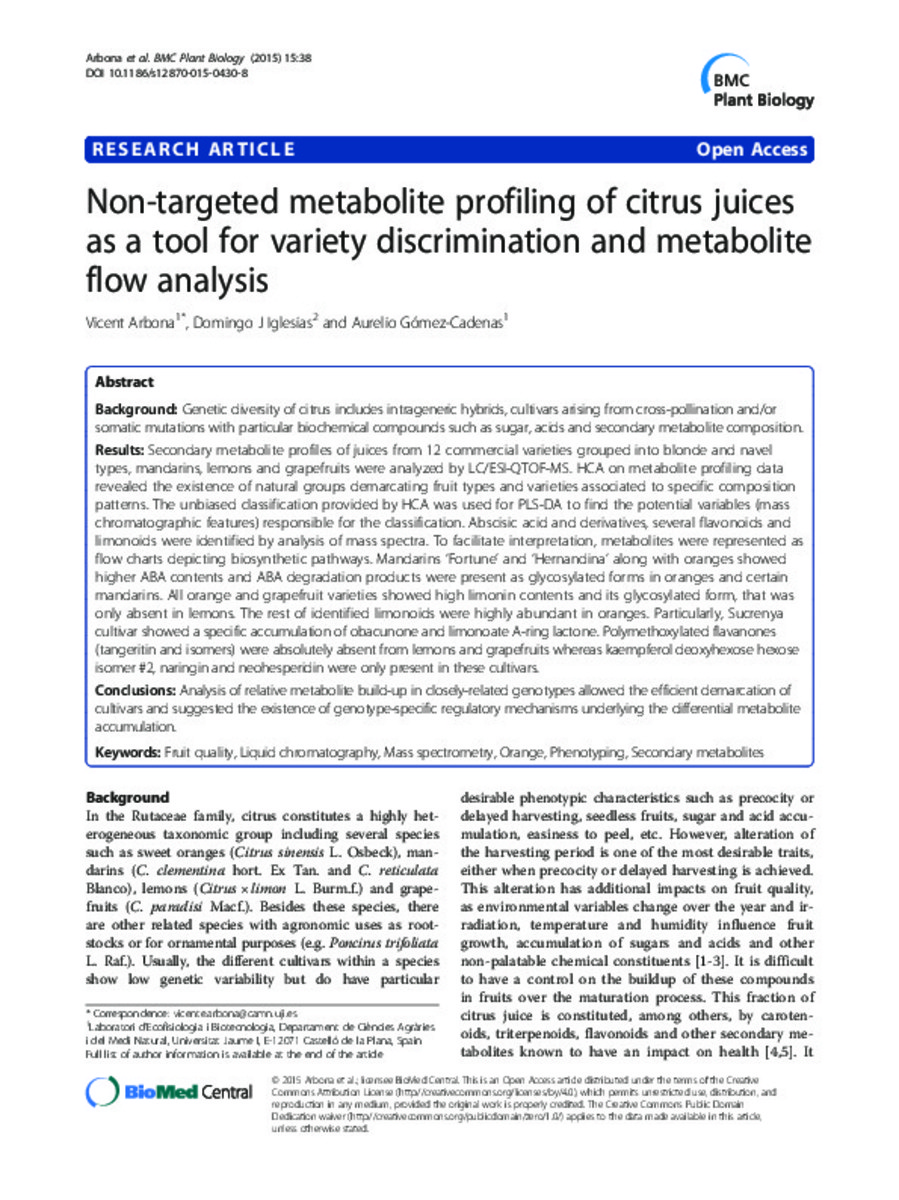Mostrar el registro sencillo del ítem
Non-targeted metabolite profiling of citrus juices as a tool for variety discrimination and metabolite flow analysis
| dc.contributor.author | Arbona, Vicent | |
| dc.contributor.author | Iglesias, Domingo J. | |
| dc.contributor.author | Gomez-Cadenas, Aurelio | |
| dc.date.accessioned | 2016-02-22T11:24:24Z | |
| dc.date.available | 2016-02-22T11:24:24Z | |
| dc.date.issued | 2015-02-05 | |
| dc.identifier.citation | ARBONA, Vicent; IGLESIAS, Domingo J.; GÓMEZ-CADENAS, Aurelio. Non-targeted metabolite profiling of citrus juices as a tool for variety discrimination and metabolite flow analysis. BMC plant biology, 2015, vol. 15, no 1, p. 1. | ca_CA |
| dc.identifier.issn | 1471-2229 | |
| dc.identifier.uri | http://hdl.handle.net/10234/150912 | |
| dc.description.abstract | Background Genetic diversity of citrus includes intrageneric hybrids, cultivars arising from cross-pollination and/or somatic mutations with particular biochemical compounds such as sugar, acids and secondary metabolite composition. Results Secondary metabolite profiles of juices from 12 commercial varieties grouped into blonde and navel types, mandarins, lemons and grapefruits were analyzed by LC/ESI-QTOF-MS. HCA on metabolite profiling data revealed the existence of natural groups demarcating fruit types and varieties associated to specific composition patterns. The unbiased classification provided by HCA was used for PLS-DA to find the potential variables (mass chromatographic features) responsible for the classification. Abscisic acid and derivatives, several flavonoids and limonoids were identified by analysis of mass spectra. To facilitate interpretation, metabolites were represented as flow charts depicting biosynthetic pathways. Mandarins ‘Fortune’ and ‘Hernandina’ along with oranges showed higher ABA contents and ABA degradation products were present as glycosylated forms in oranges and certain mandarins. All orange and grapefruit varieties showed high limonin contents and its glycosylated form, that was only absent in lemons. The rest of identified limonoids were highly abundant in oranges. Particularly, Sucrenya cultivar showed a specific accumulation of obacunone and limonoate A-ring lactone. Polymethoxylated flavanones (tangeritin and isomers) were absolutely absent from lemons and grapefruits whereas kaempferol deoxyhexose hexose isomer #2, naringin and neohesperidin were only present in these cultivars. Conclusions Analysis of relative metabolite build-up in closely-related genotypes allowed the efficient demarcation of cultivars and suggested the existence of genotype-specific regulatory mechanisms underlying the differential metabolite accumulation. | ca_CA |
| dc.description.sponsorShip | This project was funded by the Spanish Ministerio de Economia y Competitividad (MINECO) and Universitat Jaume I through grants AGL2013-42038-R and P1 1B2013-23, respectively, to Aurelio Gómez-Cadenas. LC/ESI-QTOF-MS measurements were carried out at Central Instrument Facilities (SCIC) of Universitat Jaume I, assistance of Dr. Cristian Vicent in mass spectrometric measurements is greatly acknowledged. | ca_CA |
| dc.format.extent | 16 p. | ca_CA |
| dc.format.mimetype | application/pdf | ca_CA |
| dc.language.iso | eng | ca_CA |
| dc.publisher | BioMed Central | ca_CA |
| dc.relation.isPartOf | BMC plant biology, 2015, vol. 15, no 1 | ca_CA |
| dc.rights | © Arbona et al.; licensee BioMed Central. 2015 This is an Open Access article distributed under the terms of the Creative Commons Attribution License (http://creativecommons.org/licenses/by/4.0), which permits unrestricted use, distribution, and reproduction in any medium, provided the original work is properly credited. The Creative Commons Public Domain Dedication waiver (http://creativecommons.org/publicdomain/zero/1.0/) applies to the data made available in this article, unless otherwise stated. | ca_CA |
| dc.rights.uri | http://creativecommons.org/licenses/by-sa/4.0/ | |
| dc.subject | Fruit quality | ca_CA |
| dc.subject | Liquid chromatography | ca_CA |
| dc.subject | Mass spectrometry | ca_CA |
| dc.subject | Orange | ca_CA |
| dc.subject | Phenotyping | ca_CA |
| dc.subject | Secondary metabolites | ca_CA |
| dc.title | Non-targeted metabolite profiling of citrus juices as a tool for variety discrimination and metabolite flow analysis | ca_CA |
| dc.type | info:eu-repo/semantics/article | ca_CA |
| dc.identifier.doi | http://dx.doi.org/10.1186/s12870-015-0430-8 | |
| dc.rights.accessRights | info:eu-repo/semantics/openAccess | ca_CA |
| dc.relation.publisherVersion | http://bmcplantbiol.biomedcentral.com/articles/10.1186/s12870-015-0430-8 | ca_CA |
Ficheros en el ítem
Este ítem aparece en la(s) siguiente(s) colección(ones)
-
CAMN_Articles [566]
Excepto si se señala otra cosa, la licencia del ítem se describe como: © Arbona et al.; licensee BioMed Central. 2015
This is an Open Access article distributed under the terms of the Creative Commons Attribution License (http://creativecommons.org/licenses/by/4.0), which permits unrestricted use, distribution, and reproduction in any medium, provided the original work is properly credited. The Creative Commons Public Domain Dedication waiver (http://creativecommons.org/publicdomain/zero/1.0/) applies to the data made available in this article, unless otherwise stated.








